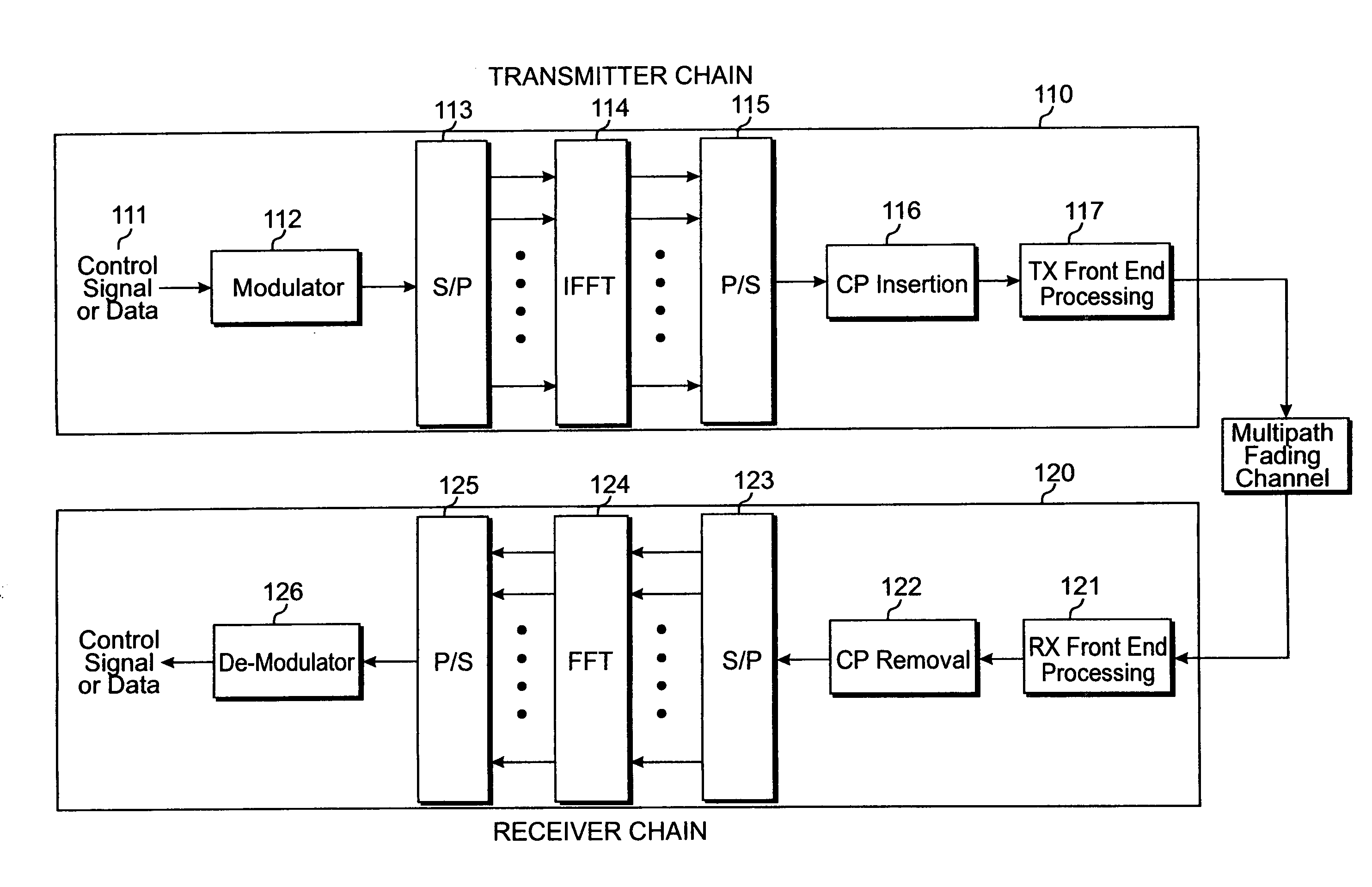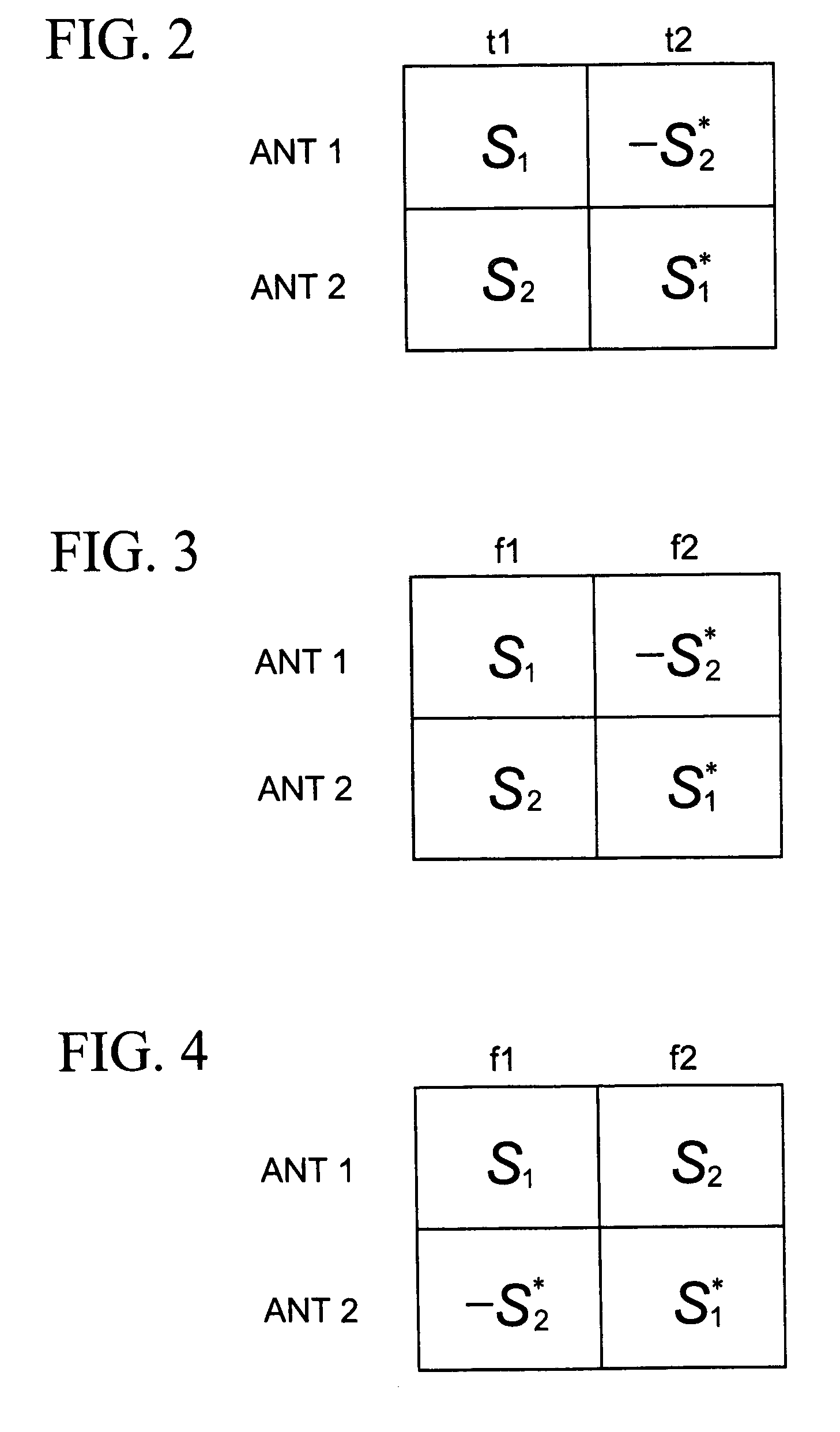Pilot boosting and traffic to pilot ratio estimation in a wireless communication system
pilot ratio technology, applied in the field of pilot boosting and traffic to pilot ratio estimation in a wireless communication system, can solve the problems of inefficient power use, small changes in differential propagation delay, and experiences constructive and destructive additions
- Summary
- Abstract
- Description
- Claims
- Application Information
AI Technical Summary
Benefits of technology
Problems solved by technology
Method used
Image
Examples
first embodiment
[0075]In a first embodiment according to the principles of the present invention, different power levels are used for data transmission on different antenna ports in each OFDM symbol using a SFBC-FSTD scheme as shown in FIG. 12. The data modulation symbols S1 and S2 are transmitted over antennas ports ANTP 0 and ANTP 2 with respective scaling factors α0 and α2, while symbols S3 and S4 are transmitted over antenna ports ANTP 1 and ANTP 3 with respective scaling factors α1 and α3, as given by the transmit matrix below.
T=[T11T12T14T15T21T22T24T25T31T32T34T35T41T42T44T45]=[α0S1-α0S2*0000α2S3-α2S4*α1S2α1S1*0000α3S4α3S3*](13)
where Tij represents the symbol transmitted on the ith antenna port and the jth subcarrier. Note although this mapping from symbols to antenna ports is preferred in LTE system, the techniques disclosed in this invention certainly apply when the mapping of symbols to antenna ports is different. For example, the symbols S1 and S2 could be mapped to antenna ports 0 and 1...
second embodiment
[0085]In a second embodiment according to the principles of the present invention as shown in FIG. 15, reference signals are power boosted relative to data signals. Assuming a power of P available per subcarrier, we assume that a total power of 6P is available for transmission over 6 subcarriers. We also assume that each of the reference signals R0, R1, R2 and R3 uses a power of 4P per subcarrier. Since a given antenna port only transmit one RS symbol over every six subcarriers, the antenna port can use the power from subcarrier position allocated for the other antenna port. For example, ANTP 0 can use the power for R0 transmission in the first OFDM symbol for its subcarrier position f6, and also subcarrier position for R1 (f3). We also note that in the SFBC-FSTD scheme, each antenna transmit over half the subcarriers while leaving the remaining half subcarriers empty. Therefore, the power per data modulation symbol using SFBC-FSTD scheme from ANTP 0 and ANTP 1 in the first OFDM sym...
third embodiment
[0087]In a third embodiment according to the principles of the present invention, MIMO spatial multiplexing transmission using precoding can employ different power levels from different antenna ports. Let us assume a two-layer (2-layer) transmission using four transmission antennas (4-Tx). We assume that the first layer (S1) is transmitted on virtual antenna 1 (first column of the Householder (HH) matrix below) and second layer (S2) is transmitted on virtual antenna 3 (third column of the HH matrix below) as shown in FIG. 16.
M1=I4-2u1u1H / u12=0.5*[111111-1-11-11-11-1-11](27)
[0088]Note that a layer refers to a MIMO stream and there can be multiple modulations symbols within a MIMO stream. The S1 and S2 shown in FIG. 16 refer to the symbols respectively from stream-1 (layer-1) and stream-2 (layer-2). A virtual antenna is obtained by precoding of antenna ports. The relationship between layers and antenna ports is illustrated by FIGS. 17A and 17B. In FIG. 17B with four antenna ports, at ...
PUM
 Login to View More
Login to View More Abstract
Description
Claims
Application Information
 Login to View More
Login to View More - R&D
- Intellectual Property
- Life Sciences
- Materials
- Tech Scout
- Unparalleled Data Quality
- Higher Quality Content
- 60% Fewer Hallucinations
Browse by: Latest US Patents, China's latest patents, Technical Efficacy Thesaurus, Application Domain, Technology Topic, Popular Technical Reports.
© 2025 PatSnap. All rights reserved.Legal|Privacy policy|Modern Slavery Act Transparency Statement|Sitemap|About US| Contact US: help@patsnap.com



